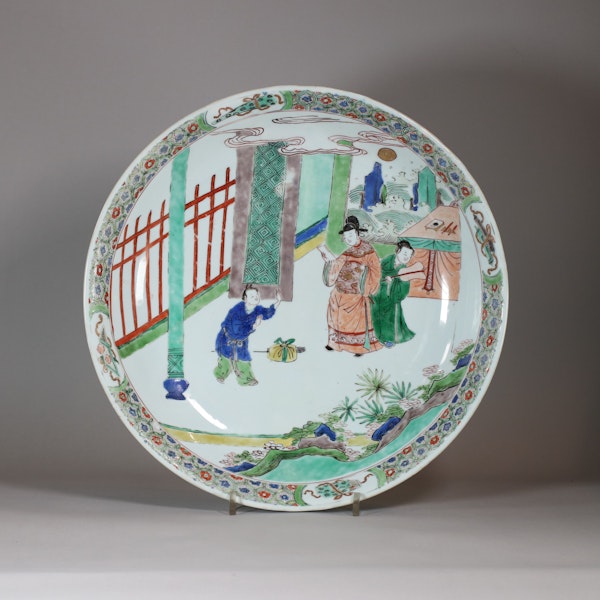Chinese famille verte plate, Kangxi (1662-1722)
Chinese famille verte plate, Kangxi (1662-1722)
POA
Description
Chinese famille verte plate, Kangxi (1662-1722), decorated to the central roundel with a scene from the play ‘Xi Xiang Ji’ (‘The Romance of the Western Chamber’) in which Zhang Sheng receives a letter and bundle of gifts from Cui Yingying; the scholar standing reading the letter at the entrance of a pagoda in a fenced garden with bamboo and rockwork, with a lavish screen decorated with waves and cliffs by moonlight visible just inside the entranceway, the young messenger with his bundle in the foreground and attendant holding a fan standing beside Zhang Sheng; the rim with four cartouches containing precious beribboned scholarly objects including a guqin, weiqi board, scrolls and books against a stippled floral cell ground; the reverse with a single artemisia leaf within a double circle.
Dimensions:
Diameter: 35cm. (11 3/4in.)
Condition: Badly damaged and well repaired.
Notes:
The Romance of the Western Chamber is a much-loved Chinese tale written in the Yuan dynasty by playwright Wang Shifu (1250-c.1337) and tells of the love between Zhang Sheng and Cui Yinying. Despite setbacks stemming from her family’s disapproval, they meet in secret with the help of Yinying’s maid Hong Niang and eventually marry. The story is one of love overcoming obstacles but also of the virtues of learning, as it is Zhang Sheng’s scholarly brilliance and his passing of the civil service examination that enables the marriage.
The scene depicted on this plate is from Part V, Act II, towards the end of the story, once Zhang Shen has passed the examination in the capital and is awaiting final imperial approval. Meanwhile, Yingying becomes sick while anxiously awaiting news until Zhang Shen sends his guqin-bearer with a letter telling of his success. In return, she sends the young boy back to the capital with her own letter and an assortment of gifts each with great symbolic value: a garment to wear at night ‘as if he and I were together’, a belt to encircle and protect him from all sides, stockings to ‘secure him from wandering astray’, a guqin to remind him of the poetry and music of their courtship, a jade hairpin in the hope that like a hair ornament, she will always be at the back of his head, and a bamboo pen in reference to an Empress who wept for her husband in a bamboo grove on the banks of the river Hsiang.
Upon receiving her letter and gifts, the scholar, whose own heart-sickness has been deemed incurable by the Imperial physician, exclaims:
‘On the branch with blossoms sings the bird of happy omen; On the curtain is suspended the lucky spider; Last night the lamp on the low stand burst into a sparkling flame, betokening good fortune./ It must be, in one form or another, a poem showing her heart-broken feelings./ When she wrote it, it is certain that her tears of love fell like rain;/ Otherwise how could the envelope be marked with the stains of her tears? […]’
He goes on to inspect the items she has sent, recognising her meaning and crying out ‘How could you fail to make me love you!’
[Translations from S.I. Hsiung, Columbia University Press: New York and London, 1968]
Provenance:
This dish is from the collection of the famous one-time Ashmolean curator Dr Oliver Impey.
| item details | |
|---|---|
| Material and Technique | Porcelain with overglaze polychrome enamel decoration in the famille verte palette |
| Origin | Chinese |
| Period | 18th Century |
| Condition | Good |
| Diameter | Diameter: 35cm. (11 3/4in.) |
Product REF: W676




